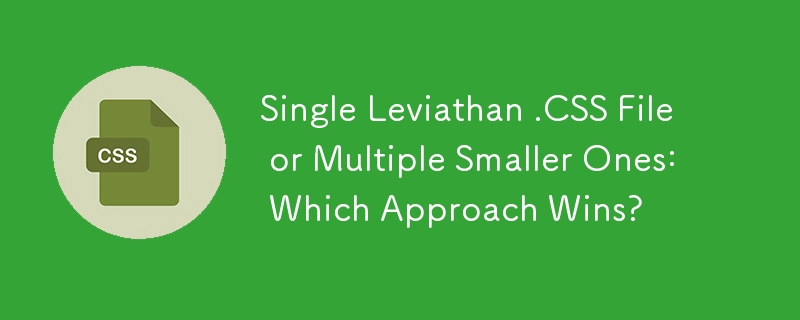 Web Front-end
Web Front-end
 CSS Tutorial
CSS Tutorial
 Single Leviathan .CSS File or Multiple Smaller Ones: Which Approach Wins?
Single Leviathan .CSS File or Multiple Smaller Ones: Which Approach Wins?
Single Leviathan .CSS File or Multiple Smaller Ones: Which Approach Wins?

The Dilemma: Single Leviathan .CSS File vs. Multiple Smaller Files
In the realm of web development, the decision between consolidating all CSS into a single massive file or splitting it into smaller, specific files remains a contentious one.
Arguments for Multiple Files
Breaking down CSS into separate files, as suggested by the author, offers several advantages:
- Ease of Management: Smaller files are easier to navigate and maintain, allowing for faster development and maintenance cycles.
- Code Reusability: Separate files enable developers to easily reuse CSS components across different pages, maintaining consistency and reducing duplication.
- Targeted Optimization: By splitting CSS into specialized files, developers can better optimize performance by including only the necessary styles in each page.
Arguments for a Single File
Consolidating all CSS into a single file also has its merits:
- Reduced HTTP Requests: Loading a single file eliminates the need for multiple HTTP requests, potentially improving page load speed.
- Simpler Deployment: Managing a single file during deployment is more efficient and reduces the risk of configuration errors.
The Best of Both Worlds
Ultimately, the choice between single and multiple CSS files depends on the specific project requirements and development workflow. However, a compelling hybrid approach is to combine separate CSS files in a development environment for readability and maintenance, while concatenating them into a single file before deployment for optimal performance.
Caching Techniques
Regardless of the approach chosen, caching on the client side can further reduce HTTP requests and enhance website performance by storing frequently accessed files locally. Techniques like browser caching and HTTP caching can be implemented to improve page load times and user experience.
Build Processes and Tools
To streamline the process of combining CSS files, consider using build processes and tools like bundler. These tools automate the minification and concatenation of separate files into a single optimized version, providing the benefits of both approaches without the overhead of runtime compression.
The above is the detailed content of Single Leviathan .CSS File or Multiple Smaller Ones: Which Approach Wins?. For more information, please follow other related articles on the PHP Chinese website!

Hot AI Tools

Undresser.AI Undress
AI-powered app for creating realistic nude photos

AI Clothes Remover
Online AI tool for removing clothes from photos.

Undress AI Tool
Undress images for free

Clothoff.io
AI clothes remover

Video Face Swap
Swap faces in any video effortlessly with our completely free AI face swap tool!

Hot Article

Hot Tools

Notepad++7.3.1
Easy-to-use and free code editor

SublimeText3 Chinese version
Chinese version, very easy to use

Zend Studio 13.0.1
Powerful PHP integrated development environment

Dreamweaver CS6
Visual web development tools

SublimeText3 Mac version
God-level code editing software (SublimeText3)

Hot Topics
 Vue 3
Apr 02, 2025 pm 06:32 PM
Vue 3
Apr 02, 2025 pm 06:32 PM
It's out! Congrats to the Vue team for getting it done, I know it was a massive effort and a long time coming. All new docs, as well.
 Building an Ethereum app using Redwood.js and Fauna
Mar 28, 2025 am 09:18 AM
Building an Ethereum app using Redwood.js and Fauna
Mar 28, 2025 am 09:18 AM
With the recent climb of Bitcoin’s price over 20k $USD, and to it recently breaking 30k, I thought it’s worth taking a deep dive back into creating Ethereum
 Can you get valid CSS property values from the browser?
Apr 02, 2025 pm 06:17 PM
Can you get valid CSS property values from the browser?
Apr 02, 2025 pm 06:17 PM
I had someone write in with this very legit question. Lea just blogged about how you can get valid CSS properties themselves from the browser. That's like this.
 Stacked Cards with Sticky Positioning and a Dash of Sass
Apr 03, 2025 am 10:30 AM
Stacked Cards with Sticky Positioning and a Dash of Sass
Apr 03, 2025 am 10:30 AM
The other day, I spotted this particularly lovely bit from Corey Ginnivan’s website where a collection of cards stack on top of one another as you scroll.
 A bit on ci/cd
Apr 02, 2025 pm 06:21 PM
A bit on ci/cd
Apr 02, 2025 pm 06:21 PM
I'd say "website" fits better than "mobile app" but I like this framing from Max Lynch:
 Comparing Browsers for Responsive Design
Apr 02, 2025 pm 06:25 PM
Comparing Browsers for Responsive Design
Apr 02, 2025 pm 06:25 PM
There are a number of these desktop apps where the goal is showing your site at different dimensions all at the same time. So you can, for example, be writing
 Using Markdown and Localization in the WordPress Block Editor
Apr 02, 2025 am 04:27 AM
Using Markdown and Localization in the WordPress Block Editor
Apr 02, 2025 am 04:27 AM
If we need to show documentation to the user directly in the WordPress editor, what is the best way to do it?
 Why are the purple slashed areas in the Flex layout mistakenly considered 'overflow space'?
Apr 05, 2025 pm 05:51 PM
Why are the purple slashed areas in the Flex layout mistakenly considered 'overflow space'?
Apr 05, 2025 pm 05:51 PM
Questions about purple slash areas in Flex layouts When using Flex layouts, you may encounter some confusing phenomena, such as in the developer tools (d...





